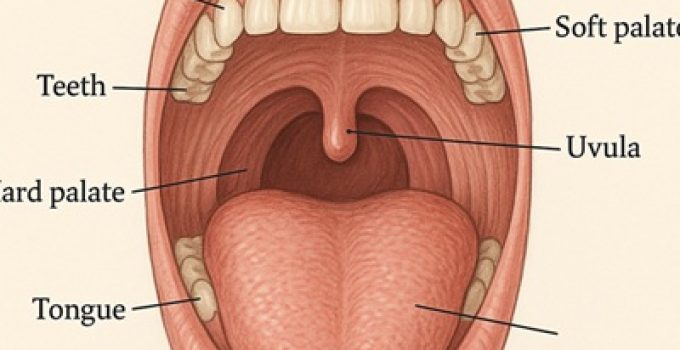What Does the Uvula Do?
The uvula—the small, fleshy projection hanging at the back of your throat—is more than just a visual curiosity. Formally known as the palatine uvula, it plays key roles in speech, swallowing, saliva production, and immune function. Though often overlooked, the uvula is a critical anatomical structure that contributes to the oropharyngeal complex.
📖 Dive Deeper
- What Is the Uvula?
- Functions of the Uvula
- Uvula and Speech
- Uvula and Swallowing
- Uvula Disorders
- Interesting Facts About the Uvula
- 🎯 Final Thoughts
- 📚 References
What Is the Uvula?
The uvula is a conical projection of mucous membrane, connective tissue, muscle fibers, and glands, hanging from the posterior edge of the soft palate. It is unique to humans and is composed primarily of the musculus uvulae, a small muscle that can change the shape and position of the uvula.
Functions of the Uvula
Despite its small size, the uvula performs several distinct and important functions:
| Function | Description |
|---|---|
| Speech articulation | Helps create specific phonetic sounds, especially in certain languages |
| Swallowing | Aids in sealing off the nasal cavity during swallowing |
| Lubrication | Secretes saliva to keep the throat moist |
| Immune response | Plays a minor role in filtering pathogens as part of the oropharynx |
| Gag reflex | Helps trigger the reflex that prevents choking |
Uvula and Speech
The uvula is critical for articulating guttural or uvular consonants, found in languages such as French, Arabic, and German. For example, the French “r” (as in rouge) is a uvular fricative, produced by airflow and vibration around the uvula.
A study published in the Journal of Voice found that individuals with bifid uvula (a split or forked uvula) sometimes struggle with resonance and precise articulation due to the altered vibration dynamics during speech [1].
Uvula and Swallowing
One of the uvula’s most important roles is to act as a soft barrier during swallowing. When we swallow, the soft palate and uvula elevate to block the nasopharynx, preventing food or liquid from entering the nasal passages. This movement is part of the pharyngeal phase of swallowing, a reflexive process coordinated by the medulla oblongata [2].
🔎 Statistic: Swallowing requires the coordinated action of 26 muscles, including the musculus uvulae, according to the National Institute on Deafness and Other Communication Disorders (NIDCD) [3].
Uvula Disorders
The uvula can become enlarged, inflamed, or malformed due to several conditions:
- Uvulitis: Inflammation due to infection or trauma; can cause sore throat and difficulty breathing.
- Snoring and sleep apnea: An elongated uvula may contribute to obstructive sleep apnea by blocking the airway during sleep.
- Bifid uvula: A congenital split in the uvula, sometimes associated with submucous cleft palate.
In severe cases of sleep apnea, the uvula may be partially or fully removed through a procedure known as uvulopalatopharyngoplasty (UPPP). While this can reduce airway obstruction, it may impact speech or increase throat dryness [4].
Interesting Facts About the Uvula
- ✅ Uniquely human: The uvula is not found in most mammals—humans are one of the few species with a pronounced one.
- 💧 Saliva factory: The uvula produces a thin, watery mucus that contributes to saliva flow during speech and swallowing.
- 🗣️ Essential in some languages: People who lose their uvula may struggle to pronounce uvular sounds common in Semitic and Caucasian languages.
- 😮 Trigger point: The uvula is part of the gag reflex, which helps prevent choking or aspiration.
🎯 Final Thoughts
The uvula may seem like an insignificant structure dangling at the back of your throat, but it serves a remarkably diverse set of functions. From helping us articulate complex phonemes to ensuring food goes down the right way, this tiny appendage is crucial to the mechanics of the oral and pharyngeal systems. Understanding its anatomy and roles can deepen our appreciation for the complexity of the human mouth—and offer insight into health issues like sleep apnea, speech disorders, and immune defense.
📚 References
- Kummer, A. W. (2001). “Speech evaluation for patients with cleft palate.” Journal of Craniofacial Surgery, 12(2), 133–138. https://doi.org/10.1097/00001665-200103000-00004
- Logemann, J. A. (1998). Evaluation and Treatment of Swallowing Disorders. Pro-Ed.
- National Institute on Deafness and Other Communication Disorders (NIDCD). “Swallowing Disorders.” https://www.nidcd.nih.gov/health/swallowing-disorders
- American Academy of Otolaryngology–Head and Neck Surgery. “Uvulopalatopharyngoplasty (UPPP).” https://www.entnet.org/resource/uvulopalatopharyngoplasty/
